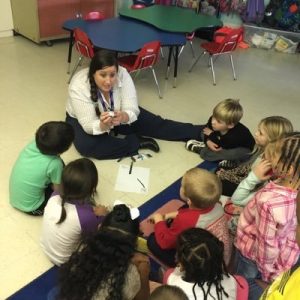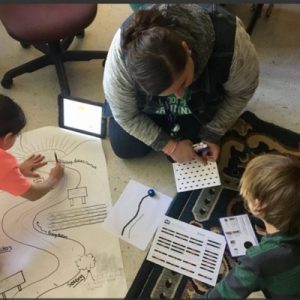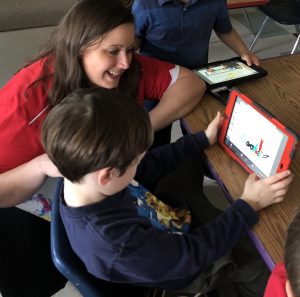The past two years have been a time of profound change in the field of education. The challenges of meeting the needs of teaching and learning during a pandemic have been significant, and teachers have had to adapt their instruction in order to teach in a variety of modalities that have been continuously shifting since the spring of 2020. In some districts, teaching transitioned from virtual asynchronous to virtual synchronous to hybrid, blended, and concurrent all within a single school year.
These shifts have required a significant amount of learning on the part of teachers. Initially, the learning was primarily training focused on new tools and platforms, such as Zoom, Canvas, Schoology, etc. Over a short period of time teachers had to master a large number of new technical and operational skills, ranging from sharing digital content in a virtual meeting to creating instructional videos using screen casting and webcams. The learning curve was steep, and coaches, leaders, and support staff worked diligently to provide training and support for teachers.
Interestingly, as this initial learning curve leveled, there was an opportunity to shift away from training toward intentional professional development. As an Instructional Technology Coach, I had an opportunity to shift my own practice and to change how I provided professional learning to my teachers in order to be responsive to their needs, to support them in adopting new blended strategies, and to model instructional practices that they had probably never experienced themselves as learners. I recognized a widespread sense of overwhelm and burnout in my teachers, and I was determined to find ways to support them while also improving teaching and learning.
In this post, I hope to share what I have learned and how I have found success with providing professional learning that allows my teachers to experience strategies from the learner’s perspective, understand why best practices for engagement and learner-centered strategies really work, and have some fun along the way.
From Fire Hose to Sprinkler
 |
 |
Out of necessity, myself and my fellow Instructional Technology Coaches spent the summer and fall of 2020 creating and providing a lot of training for teachers on Zoom, Microsoft Teams, and Canvas. I was generating How-To documents, creating Canvas training modules, offering live workshops, sending out How-To videos almost daily, and providing support almost around the clock. It was necessary, but it was overwhelming and the focus was on getting up and running and “how” to use the tools. During this time the teachers felt like they were trying to drink from a firehose, and I felt like I was the firehose.
Eventually, teachers became more comfortable with the basics and could use the tools to function, and I found myself needing to provide less training. I wanted to start working on moving teachers from how to use the tools to why to use them, and how to use them well. I wanted to shift from an operational focus to an emphasis on pedagogy and how to teach effectively in these new learning environments. However, teachers were still in a space of overwhelm and I needed to find a new approach. I needed to put down the firehose.
I decided to be a sprinkler instead of a firehose. I wanted to move away from mandatory training to optional professional learning that would appeal to teachers and support them in the challenges they were facing. The firehose is a high-volume stream of water that puts out a fire by saturating it and stepping in front of it can be painful. A sprinkler, on the other hand, is a fun way to cool off and you can choose to run quickly through or jump in and get soaked. I wanted to offer a sprinkler that teachers could come and play in to dip their toe in for a little information, or to run through at their own pace for a lot of information. I asked teachers want they wanted in their professional learning sessions and what would make them worth attending. The feedback I received is shown in the word cloud below.
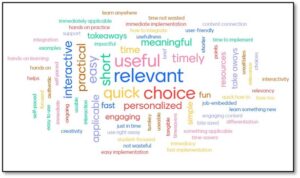
I started with a professional learning model I coined Try-ITs, which stands for Try Instructional Technology. I designed these Try-IT workshops to provide teachers with an opportunity to try new tools and strategies as learners first before attempting to utilize them as teachers. I had a lot of success with this model and have since presented on the framework at conferences around the country. This year I have built upon this framework and continue to adapt to meet the needs of my teachers. I have discovered three strategies for designing professional development that have been very successful that I want to share, which are allowing teachers to be learners, modeling high impact teaching and engagement strategies, and incorporating fun.
Teachers as Learners
It has long been accepted that adults and children learn differently. In fact, the fields of pedagogy and andragogy are filled with research on the differences between these two types of learners. Malcolm Knowles was an American educator known for using the term andragogy to describe adult learning. Knowles developed five assumptions of adult learners and four principles of andragogy, shown in the graphic below, in the 1980s that established ways in which adults learned differently from children.
However, there is an alternative view emerging in which the fields of andragogy and pedagogy can be viewed as having overlap or commonalities. A new term, metagogy, is gaining traction as the “framework for selecting contextually appropriate teaching practices. It offers up a both-and process for developing and implementing methods, strategies, and techniques for educating adults.” (Stroghschen, 2020) This both-and approach allows for the realization that teachers can benefit from some of the same learning strategies as their students. Nina Smith, Mentor for Teacher Education at Western Governors University, states that “when teaching is seen primarily as an attempt to empower students to learn autonomously by providing support, feedback and resources for that learning, there is not a big difference in teaching adults or kids… Deep learning happens in the same way in children and adults: student finds learning material interesting and becomes engaged beyond the minimum requirement to complete the task” (Smith, 2013).
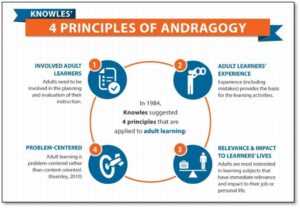
Take a closer look at the four principles of Andragogy above. The connections between each of these adult learning and student-centered instruction are clear. The first principle states that adults need to be involved in the planning and evaluation of their instruction. This connects to student voice and choice, students constructing their own knowledge, and students self-assessing. The second principle refers to experience and learning from mistakes as critical to adult learning. This ties directly to differentiating learning based on our students and their life experiences and providing timely and personalized feedback to help them learn from their mistakes.
The third principle discusses relevance of content, interest in subjects, and impact on learners’ lives. This is clearly important for our K-12 students as well, and we are always working to provide authentic, personalized, and relevant learning experiences. Finally, the fourth principle indicates that learning should be problem-centered rather than content-oriented. Education has emphasized in recent years that project-based learning, performance tasks, and thinking and problem-solving skills are essential for improving learning for K-12 students.
Capitalizing on these deeper learning strategies in both adult and student learning is what moves learning from performative to transformative in any setting. Nina Smith concludes that “even though there are apparent differences between children and adults as students, the same basic principles of meaningfulness and personalized learning must be present for both groups to prevent potentially transformative learning from turning to an externalized performance.” (Smith, 2013)
Having taught both children and adults over the course of my profession, I agree wholeheartedly that there is an overlap between the best approaches for teaching both groups. I have been able to apply this mindset by designing professional learning that provides teachers with the opportunity to engage in learning in much the same way we want to provide learning for our students. Some examples are providing teachers with voice and choice in what, how, and when they learn, making professional learning engaging and active, and modeling the same high impact instructional strategies that we want teachers to use in their own instruction. I approach designing professional learning in the same way that I would approach designing instruction for students. I want to move away from “sit and get” delivery and training, to meaningful learning experiences in which teachers can expand their understanding of how learning feels in student-centered versus traditional instructional models.
As the field of education is ever-changing, especially in the area of education technology, it is essential that teachers embrace the role of lifelong learners. To that end, professional learning should be relevant, engaging, and fun – not overwhelming and unpleasant.
Modeling Strategies
According to an Edutopia post titled “How to Create Meaningful PD”, modeling instructional practices and providing a variety of tools are essential for effective professional development sessions (Plotinsky, 2020). I have found this to be especially true in recent years, as instructional practices are shifting from teacher-centered to learner-centered and as educational technology is increasing in availability and usability. Many teachers came through the educational system as learners in more traditional environments and with limited technology. Even the most veteran and skilled teachers are always looking for ways to grow and improve their practice, and sometimes they need help understanding what strategies that are new to them look like. How can we expect teachers to teach in ways that they have never experienced as learners? The answer is by modeling these instructional practices and tools with teachers as learners.
As the Chinese proverb goes: Tell me I forget, show me I remember, involve me I understand. I can tell teachers how effective a strategy is, but to show them by letting them experience the strategy as a learner is when I usually see the “A-ha” moments. Once that light bulb goes on in their minds, I can involve teachers organically because they connect with the new strategy and often begin brainstorming and collaborating on how they are going to start using it. I love it when this happens during the professional learning session and I can move from modeling to facilitating, and it is exciting to see where they take the learning.
This year I have been focusing on pairing instructional strategies with high effect sizes, based on John Hattie’s research on visible learning, with some of the education technology tools and platforms we already have in place in our division. My goal is to increase the use of these research-based strategies while also increasing the effective use of the technology. As an example, consider the jigsaw method as an instructional strategy and Nearpod as an edtech tool. If I were leading a professional learning on these two topics, I would model how to use Nearpod’s interactive features to conduct a jigsaw learning activity. I would break teachers into groups or use breakout rooms, provide a variety of resources on different aspects of the jigsaw method, have each teacher in a group interact with a different jigsaw resource, and then report back to their group on their learning.
I would then showcase additional Nearpod tools by having the groups share back with the larger session. In doing this, I used the jigsaw method to teach the jigsaw method. I also modeled how to use Nearpod to effectively organize the activity and engage learners. I would also provide templates, examples, and additional resources so that teachers would leave with tools to use right away in trying out the strategies in their own classrooms.
That is just one example, but the concept can be applied to any topic you want teachers to learn about. As an Instructional Technology Coach, I always try to connect any technology tool or platform to best practices in instruction and demonstrate how to teach effectively with the tools. The graphic below provides some additional examples of instructional strategies that can be modeled directly in professional learning by allowing teachers to take on the role of learners. Can you imagine all the educational technology platforms that could be used to model each of these strategies?
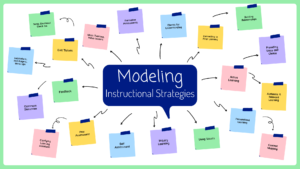
Finally, I have learned that through all of the challenges of embracing lifelong learning and adapting to teaching during a pandemic, teachers crave connection and fun. Running through a sprinkler is a fun way to cool off on a hot summer day, and professional learning when designed effectively can be a pleasant way to connect with colleagues and enjoy learning new strategies and improving practice. When I first introduced the Try-IT workshops, I intentionally incorporated fun and games into every session. There were some weeks when it felt like attending these sessions and “TRYing” out new things together was the only time I saw teachers smile or laugh. In a time when we were teaching remotely through screens and quarantining in our own classrooms or even homes, professional learning activities were a time for connection and collaboration.
Another takeaway I have learned from trying to make professional learning fun and encouraging teachers to attend is that most teachers love to be rewarded and many of them love healthy competition. I now know that giving a teacher a sticker to show off on a sticker chart can be a strong motivator. I have learned that the science teachers want to win over the math teachers, and that they will attend, participate, and do almost anything to earn points and try to win a school-wide competition.
This is an element of fun that I had not ever considered before the pandemic. It’s not as though the ideas weren’t out there, but I had been focused more on what I wanted to teach my teachers than how to make their learning fun. What a game changer! Now, I don’t offer any professional learning without awarding some sort of prize or badge. I often hold raffle drawings or BINGO contests for attendance, and I always look for ways to foster healthy, fun competition between teachers or groups. Not only has this made my professional learning sessions more fun for my teachers, but it has made them more fun for me. The best part is that even these fun ideas are modeling strategies that teachers can use to make learning more fun for their own students.
Some ways that I have made professional learning fun over the past two years are sticker charts, department competitions, march madness competitions, digital badging, door prizes, raffle drawings, BINGO cards for session attendance, shoutouts at faculty meetings and lots and lots of engaging games and fun during the sessions themselves. In addition, I have been encouraging my teachers to start sharing their learning by leading mini PD sessions themselves. I have held Monday Make & Takes, Tuesday Sip & Shares, and Try-IT-athons, just to name a few. I have started collecting ideas for making PD fun that I hope to incorporate going forward and have shared some of these in Figure 4. The learning is always centered around what teachers need most and how to model strategies while they take on the role of student, but having fun is a great way to keep them attending and just add some joy to all of our professional lives.
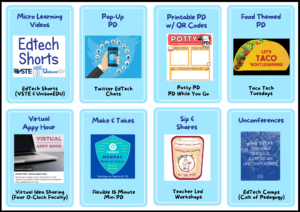
The past two years have brought incredible challenges to teaching and learning, and educators have had to do a lot of learning and adapting to meet the needs of students in a dynamically changing instructional landscape. As an Instructional Technology Coach, I have had to adapt my practices to meet the needs of teachers as they shift their instruction to rise up and meet these challenges. It has been one of the hardest and also most rewarding times of my professional career. Just as teachers have had to redesign instruction to continue incorporating student-centered in new blended learning environments, I have worked to redesign professional learning to best support teachers as learners.
I have had success in focusing on the three strategies outlined in this post: allowing teachers to take on the role of learners, modeling research-based best practices for engagement and instruction, and finding ways to infuse fun, rewards and connection into every session. I hope that these strategies might inspire other coaches and leaders to find innovative ways to support teachers in growing their practices and pursuing lifelong learning. I have enjoyed sharing these ideas at conferences and connecting with other educators along the way, and I hope you we can continue sharing ideas to support teaching and learning as a community. Let’s connect and make teaching and learning fun!
Written by Emily Heller. Emily is an Instructional Technology Coach in Fredericksburg, Virginia. She is a Director on the VSTE Board and a member of the VSTE Coaching Crew. Emily has presented on her professional learning frameworks at VSTE, VASCD, TCEA, and FETC conferences. Connect with her on Twitter @emilyhellertech.
References
Hocutt, D. (2018, April 19). Adult Learning Theory: Malcom Knowles & Andragogy. Retrieved from SPCS Pedagogy Community: https://blog.richmond.edu/pedagogy/adult-learning-theory-malcolm-knowles-andragogy/
Smith, N. (2013, January 1). Andragogy and Pedagogy: Similarities in Teaching Adults and K-12 Students. Retrieved March 2022, from The Evolllution: A Modern Campus Illumination: https://evolllution.com/opinions/andragogy-and-pedagogy-similarities-in-teaching-adults-and-k-12-students/
Stroghschen, G. (2020). By Means of Critical Theory: Informed Emancipatory Eduation - An Essay on REalities and Possiblities. In V. Wang, Handboook of Research on Ethical Challenges in Higher Education Leadership and Administration (pp. 296-308). IGI Global. Retrieved from https://doi.org/10.4018/978-1-7998-4141-8.ch016
Technology Resources
The word cloud shown in Figure 1 was generated using Mentimeter. Figure 2 which was adapted from an eLearning Industry infographic as cited. All other graphics were designed utilizing Canva for Educators.
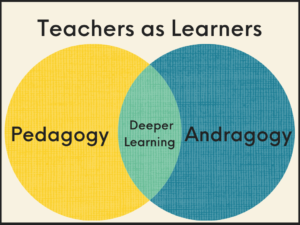
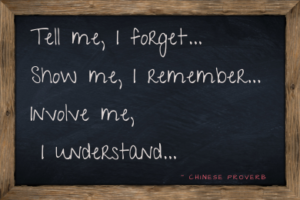

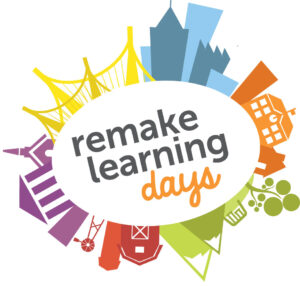 Remake Learning Days have come to the Delaware-Maryland-Virginia region. The celebration focuses on innovative, engaging opportunities for youth to experience learning. It continues through May 22, 2021, and many organizations including schools, museums, libraries, after school organizations, early child care centers, universities, media centers, tech startups and more are hosting hands-on, family friendly events related to the themes of Arts, Maker, Outdoor Learning, Science, Technology and Youth Voice. You can learn more at
Remake Learning Days have come to the Delaware-Maryland-Virginia region. The celebration focuses on innovative, engaging opportunities for youth to experience learning. It continues through May 22, 2021, and many organizations including schools, museums, libraries, after school organizations, early child care centers, universities, media centers, tech startups and more are hosting hands-on, family friendly events related to the themes of Arts, Maker, Outdoor Learning, Science, Technology and Youth Voice. You can learn more at 